Crossfit Open 2016 took place from February 25 to March 28, 2016.
During the Crossfit Open, a workout was released. each week. I was fortunate to cover and assess sports injuries at my local box, Crossfit 852 3 of the 5 workouts. I was able to snap some quick photos, you can see below.
16.1- Most athletes came with complaints of knee and hip pain. Achy, sore patella tendon and quad muscles were normal after seeing a AMRAP consisting of that many lunges. Had 1 or 2 elbow complaints but nothing major.
Complete as many rounds and reps as possible in 20 minutes of:
25-ft. overhead walking lunge
8 burpees
25-ft. overhead walking lunge
8 chest-to-bar pull-ups
Men lunge 95 lb.
Women lunge 65 lb.
16.2- Some lower back and hip problems aggravated by flexion. This may have been due to both the toes to bar causing some flare up of flexion based back pain. Hip pain tended to from the squat cleans.
Beginning on a 4-minute clock, complete as many reps as possible of:
25 toes-to-bars
50 double-unders
15 squat cleans, 135 / 85 lb.
If completed before 4 minutes, add 4 minutes to the clock and proceed to:
25 toes-to-bars
50 double-unders
13 squat cleans, 185 / 115 lb.
And so on…
16.3- I was not present during 16.3 but the following weeks I did have some clients come to the office with complaints of rotator cuff problems (possible tendon tears and muscle pulls) due to the bar muscle up. Many of this years competitors may have not trained for bar muscle ups and I saw some poor form rather than scaling.
Complete as many rounds and reps as possible in 7 minutes of:
10 power snatches
3 bar muscle-ups
Men use 75 lb.
Women use 55 lb.
16.4- Probably the hardest of the open. The men had to dead lift for reps which is always very tough. Many of the athletes have lifted 225 lbs previously but not for 55 reps so back pain was the most prominent complaint. The second most was neck pain. Looking up to throw during the wall balls, then having to do hand stand push ups and falling on your head and neck can definitely hurt the neck a bit.
Complete as many rounds and reps as possible in 13 minutes of:
55 deadlifts
55 wall-ball shots
55-calorie row
55 handstand push-ups
Men deadlift 225 lb. and throw 20-lb. ball to 10-ft. target
Women deadlift 155 lb. and throw 14-lb. ball to 9-ft. target
16.5 – Not present. Few injuries were reports, if at all.
21-18-15-12-9-6-3 reps for time of:
Thrusters
Burpees
Men use 95 lb.
Women use 65 lb.
One thing that has to be mentioned is that Crossfit is a Sport. Like any other Sport, there is a risk of injury.
